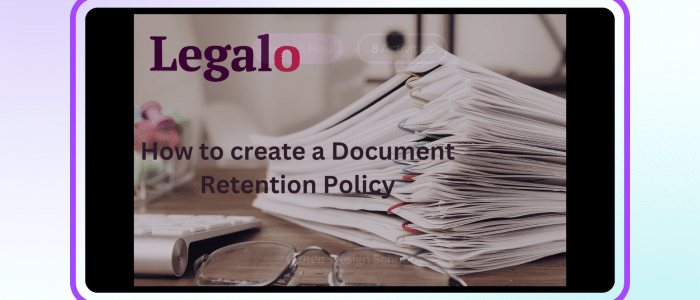How To Create a Document Retention Policy
Posted by Stephen on November 12, 2023
In this guide we answer the question of ‘how do you create a document retention policy’. We cover:
- What to include in a document retention policy;
- The benefits of a well drafted document retention policy; and
- The steps to follow when creating a document retention policy.
A document retention policy is a set of guidelines and requirements for the management and retention of documents within an organisation.

A clear document retention policy (DRP) will assist businesses in improving security and business efficiency. A DRP should cover both physical and digital documents that are created by the business or that come into its possession.
Advice tip – It is advisable to also include email as a document form within the policy. Email storage and retention is often overlooked. Emails can often provide evidence of what was agreed with a party, should it be questioned long after the event.
So the objective of a data retention policy is to set out clear requirements for the document life cycle.
What to Include in A Document Retention Policy
The policy should include:
- The Purpose of the policy. It is useful to start the policy with an introductory statement that states why the policy exists and how it benefits the business.
- The scope of the retention policy. I.e. what document types are covered. So this requires first identifying the document types that apply to your business. These may typically include: supplier contracts, customer contracts, accounting and finance records, staff and personnel records, health & safety records, property documents and records.
- Storage requirements. Include a section that sets out the storage requirements for all documents by document type. Most companies now use cloud-based storage solutions for documents. This will assist in avoiding ‘clutter’ and makes for a good document management strategy. However, it is then important to require that all physical documents received by the business are scanned and also saved to the cloud, for consistency.
- Retention Periods. Set clear retention periods for each document type. Different document types are covered by various legal requirements on document retention. It is important to understand the retention periods that apply to the document types.
- Disposal Requirements. Details of who is authorised to destroy document records, and how and when this should be done.
In preparation for writing your document retention policy, please read our guide to the legal requirements for document retention. This guide provides a comprehensive review of the time periods for which you must retain different document types.
Benefits of a Document Retention Policy

For those that are asking themselves; why have a document retention policy? There are clear business benefits from having a good document retention policy. For example, these include:
- Increasing business efficiency;
- Supporting decision making;
- Legal compliance;
- Avoiding legal penalties;
- Data security;
- Ease of retrieval; and
- Decluttering.
You should not underestimate the efficiency benefits to a business from an effective document retention policy. For example, consider how many times you have found yourself searching for a long archived document, or email, and the time wasted in that exercise.
An effective document retention policy will ensure that all documents are stored in an organised way that makes document retrieval easy and fast. This also enables better collaboration between members of the organisation. Staff will find it much easier to find documents other staff members have created if you have set a clear structure for storage of computerized records.
The most important part of creating a data retention policy is to be consistent in all aspects of the management of documents. You should establish clear creation, distribution, storage, retrieval and retention/disposal requirements.
Steps to Follow When Creating a Document Retention Policy

The section below sets out the steps you need to follow when creating a document retention policy, and offers practical guidance on implementing each step.
1. Categorisation of Records
Begin by identifying all documents used within the business and where you currently store them. This includes original ‘hard copy’ documents and also documents in electronic format. electronic formats. Also don’t forget that you should consider emails as a ‘document type’. This will enable you to then write up the ‘Scope’ of the Document Retention Policy.
2. Document Storage
Decide on the appropriate means of document storage based on the business’ technological and organisational capabilities. We strongly recommend moving to a ‘paperless’ medium for document storage. This will involve scanning paper documents to move them into a digital format utilising a ‘cloud. So you can now write up the storage section of the document retention policy.
3. Document Utility and Retention
Evaluate the importance of the different document types, as well as the legal requirements for document retention. Then this will enable you to establish how long you need to retain the documents. With this information established, then you can set out the retention requirements within the document retention policy.
4. Protocol for Document Destruction
Document destruction represents a legitimate phase in a document’s life cycle. You can destroy documents once they they have passed any legal retention period, and no longer serve a business function. So set out in the ‘document destruction’ section of the policy who is responsible for signing off documents for destruction.
5. Write the Policy
With steps 1 to 4 complete, then you will have all of the information to hand to enable you to write your document retention policy. There are many free templates available online which provide a good starting point. For example, Amazon Web Services provide one such template.
6. Regular Policy Review and Adaptation
Finally, assign responsibility within your business for periodic reviews of the document retention policy. This ensures your retention policy remains aligned with your business, and evolving legal requirements.
Once you have written the document retention policy, you should share it with all staff. Ideally, as a business owner, you will set up some staff training. Training staff on the retention policy requirements will ensure that everyone applies the same approach. Remember, consistency is the key.
Get Legal & Compliance tips straight to your inbox, free!
"*" indicates required fields